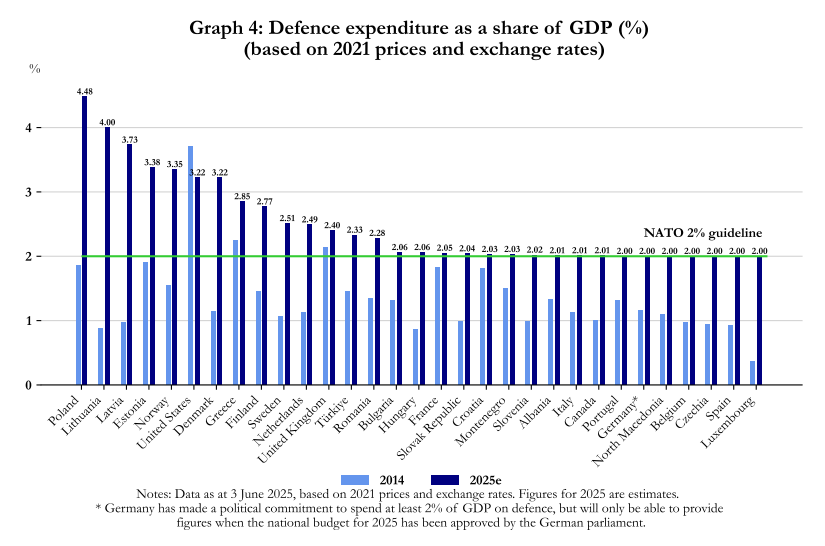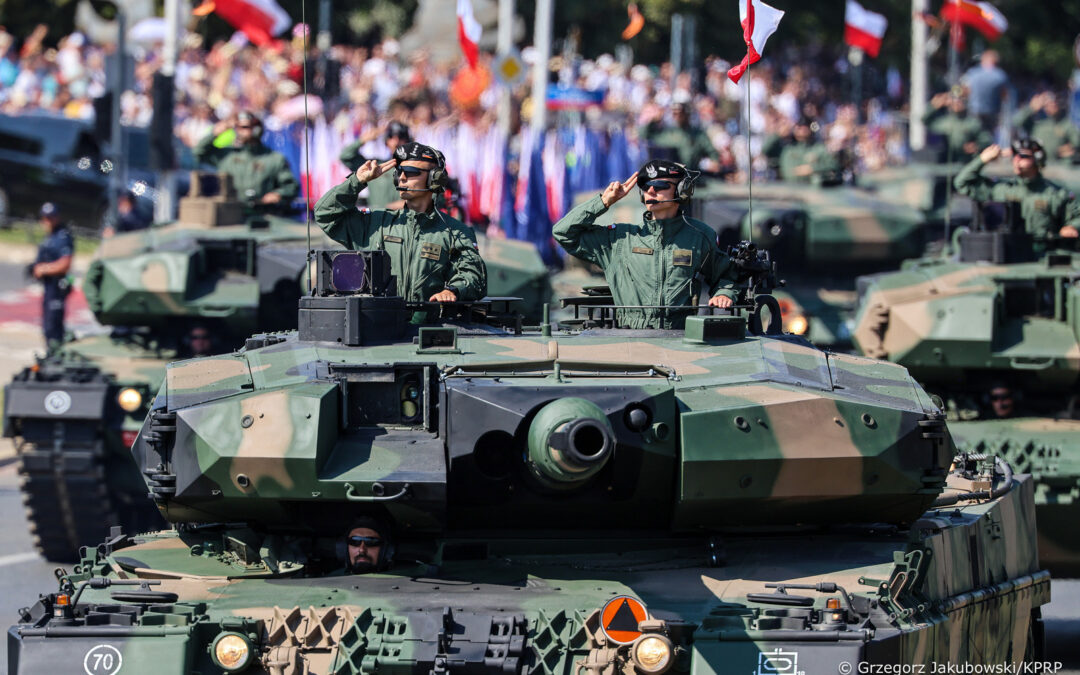Keep our news free from ads and paywalls by making a donation to support our work!

Notes from Poland is run by a small editorial team and is published by an independent, non-profit foundation that is funded through donations from our readers. We cannot do what we do without your support.
By Christiaan Paauwe
If there is one thing that Poland’s hyperpolarised political parties can agree on, it is the necessity of large-scale defence investments. Indeed, the current government and opposition have been competing in recent years when it comes to who has the most ambitious course to keep the country safe.
The numbers have been quite dramatic. Promises of a thousand Korean tanks, nearly a hundred American Apache attack-helicopters, and hundreds of advanced Himars-rocket systems.
But the major drone incursion by Russia into Poland last month has reignited a complicated question: is Poland preparing for the right kind of war?
Poland has rejected @ZelenskyyUa's suggestion that it would not be able to protect its people from a mass Russian drone attack.
The remarks were "unnecessary and untrue", says the Polish defence minister https://t.co/dz37TzTKpg
— Notes from Poland 🇵🇱 (@notesfrompoland) September 18, 2025
Some experts warn that the country’s military buildup is becoming increasingly outdated — shaped more by political posturing than by the hard lessons of modern warfare. Even with billions in spending, Poland may not be significantly safer.
“Despite the positive trend in increased defence spending, it does not translate into Poland’s actual defence capabilities”, says Dariusz Kozerawski, a professor of security studies at the Jagiellonian University. “Unfortunately, one might get the impression that it is being prepared for a war of the past.”
When the former Law and Justice (PiS) government began to dramatically ramp up Poland’s military spending in the wake of Russia’s full-scale invasion of Ukraine in 2022, there was a broad consensus about it in society.
But for a lot of analysts, the decision came late, just like in the rest of Europe, as the Russian annexation of Crimea in 2014 and the war in the Donbas had proven that peace on the European continent was not self-evident anymore.
By 2023, Poland had increased its defence budget to 4% of GDP, double the NATO norm back then. In next year’s budget, the figure is set to rise to 4.8%, amounting to a record 200 billion zlotys (€47 billion).

Poland wants to lead by example, worried that the country could become a new front line if Putin cannot be deterred. But the urgency of the situation and the desire to make up for lost years have led to strategically questionable decisions, critics say.
The PiS government promised to build “the largest land army in Europe”. That pledge, made ahead of the October 2023 parliamentary election, was, according to Kozerawski, “more propaganda than a promise of real action”. It led, for example, to the formation of two new divisions, but at the expense of existing army units.
This had a “destructive impact on the state’s defence capabilities at the time” while the country in the meantime was making “rapid, strategically ill-considered purchases”, such as Korean FA-50 fighter jet, adds Kozerawski.
That aircraft is supposed to replace Soviet-era planes in the short term but is becoming more and more of a headache for the air force because of delays and system shortfalls.
For military consultant and analyst Maciej Lisowski – who comments on defence issues via his popular YouTube channel – Poland should rethink certain high-profile procurements, including the acquisition of 96 Apaches costing over $10 billion.
These American-made attack helicopters can definitely have a role in the country’s defences. But they are incredibly expensive and have become more vulnerable on a drone-saturated battlefield. Helicopters in Ukraine are forced to keep a greater distance or risk being shot down, making them less effective.
“Ninety-six Apaches is completely crazy to me”, says Lisowski. According to him, half the number would have been more than enough. The money could be used more effectively for substantially cheaper alternative helicopters or drones.
Poland has signed a $10 billion contract with the US for 96 AH-64E Apache attack helicopters.
The deal will make Poland the second largest user of these helicopters in the world, after only the US itself https://t.co/ugJDfoENj5
— Notes from Poland 🇵🇱 (@notesfrompoland) August 14, 2024
Security analyst Marek Świerczyński of Polityka Insight, a policy analysis centre, also believes that some of the large-scale procurements were inspired more by domestic politics than clearly declared strategy.
Under the new government, the approach has not changed. If anything, the current administration, led by Prime Minister Donald Tusk, has been doubling down on the course set by PiS.
“The mood, among both the political class and among society, was such that those projects were untouchable”, says Świerczyński.
This does not mean that these purchases do not help increase the country’s defences, Świerczyński stresses. Every investment that Poland has made – such as long-range artillery and modern tanks – increases the country’s firepower and capability to defend itself.
Prime Minister @donaldtusk has announced a new “national doctrine” intended to ensure Poland has “the strongest army and economy in the region” during a celebration marking the 1,000th anniversary of the coronation of the first Polish king https://t.co/eVusG0CNY0
— Notes from Poland 🇵🇱 (@notesfrompoland) April 26, 2025
When Poland together with its allies shot down some of the Russian drones violating its airspace last month, it was initially heralded as a successful show of NATO’s resolve. Dutch F-35 pilots even celebrated their success by putting a “kill mark” of a drone on their aircraft.
But it quickly became clear that Poland and other countries on the eastern front lack anti-drone defence capabilities. Expensive jets and their expensive missiles, costing over a million euros a piece, were used to destroy cheap Russian weapons. Only three out of 21 were neutralised.
By comparison, Ukraine normally takes down over 90% of Russian swarms, which now regularly consist of more than 800 kamikaze drones. According to Kozerawski, it “clearly demonstrates years of allied and national neglect in this regard”.
NATO has since set up the “Eastern Sentry” mission, aimed at strengthening air defences along the Russian and Belarusian borders. The EU is planning to build a “drone wall” to protect against such incursions. It should be fully operational in two years.
President @NawrockiKn has approved the deployment in Poland of foreign NATO forces as part of the alliance’s response to this week’s incursion by Russian drones into Polish airspace https://t.co/MMjPKL7fRO
— Notes from Poland 🇵🇱 (@notesfrompoland) September 14, 2025
In the meantime, Poland signed a drone cooperation agreement with Ukraine. Necessary steps, says Kozerawski, but again taken too late.
“In the efforts Poland was undertaking, drones were not a priority,” says Świerczyński. But the armed forces have taken certain steps to integrate drones into their fighting capabilities, he stresses, for example when it comes to using reconnaissance drones on the battlefield.
Modern warfare, notes Świerczyński, has simply changed very rapidly in Ukraine. “Everybody is learning. Europe is learning. All of NATO is learning. I would say that everyone is lagging behind.”
Poland and Ukraine agreed to share experience and expertise in drone warfare, a week after Russian drones violated Polish airspace.
"We want to benefit from your knowledge and skills," Poland's defence minister told his Ukrainian counterpart https://t.co/WjBptry8QO
— Notes from Poland 🇵🇱 (@notesfrompoland) September 18, 2025
Still, Poland’s reinforcement of its defence capabilities was not designed to reflect the reality of the Russia-Ukraine war. It was intended to enhance and expand the capabilities of the Polish armed forces based on NATO doctrines, which are heavily reliant on air power.
In Ukraine, neither side is fully using this on the battlefield because no one has air superiority. If a war between NATO and Russia were to break out, the alliance’s dominance in the air would be overwhelming, which would make the entire nature of the conflict different.
“NATO has a large amount of jets and anti-aircraft systems. We would have the advantage in the sky along the entire front,” says Lisowski. “The enemy would not be able to use their air force and their drones like in Ukraine. So we do not need to take all the lessons from the battlefield one-to-one.”
Poland has signed a $2bn deal for the US to provide logistical support for the Patriot systems protecting Polish skies
"Let Poland be an example that loyalty to allies and investment in security is the foundation of Western civilisation," said @donaldtusk https://t.co/sOCgT4YarU
— Notes from Poland 🇵🇱 (@notesfrompoland) April 1, 2025
That being said, there is wide consensus that, when it comes to drone protection, Poland and other NATO countries have a long way to go. That, if Russia were to send up to a 1000 kamikaze drones, they cannot keep shooting them out of the air with expensive F-35s and anti-aircraft rockets.
Beyond procurement choices and anti-drone preparedness, Kozerawski sees a deeper issue: Poland has to review its strategic plans, both short and long term. Right now, big political statements and flashy contracts are meant to reassure citizens.
“In reality, the actual defence capabilities are not undergoing significant development in the short-term strategic perspective of three to five years,” the former colonel says. “The neglect of over two decades of excessive use of the peace dividend will not be remedied in a few years.”
Russia’s full-scale invasion of Ukraine has served as a wake-up call to the entire NATO alliance, and Poland has been the boldest in its response. But without this strategic reset based on modern, more cost-effective, drone-centric warfare, it might be preparing itself for a war that has already passed, while the next one is getting ever closer.

Notes from Poland is run by a small editorial team and published by an independent, non-profit foundation that is funded through donations from our readers. We cannot do what we do without your support.
Main image credit: Grzegorz Jakubowski/KPRP





















